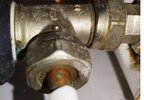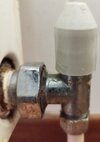Hi, I'm hoping someone can help point me in the right direction please. Struggling a bit financially at the moment and that's why I'm trying to do this myself, I have no experience of plumbing but mechanically minded, sorry for silly questions. I had it in my mind how to carry this out but I saw a post that I now can not find that was similar but they were told they would have to cut the pipes for some reason - if it involves this I'll just wait to save for a professional plumber! Have a 600x700 single panel compact radiator in bathroom of bungalow property and gravity fed system and looking to replace with similar due to the radiator corroding - appears to have done this due to condensation over the years. It's an old property, 1830's at one section and a newer section presumably done in the last 20 years where this radiator is. The property itself I would say has had a number of non-standard things done when unearthed so this may be one.
As far as I can see, the pipes routing the CH are 10mm on both the trv side and lockshield side, yet appear to be 15mm elsewhere in house. The TRV is oriented horizontally and is like that throughout the house. I think what is in place is a 15mm TRV and 15mm lockshield but I'm not sure, from underneath the TRV side it looks like a mecahnical reducer inserted but it doesn't look the same to me on the right at the lockshield so wasn't sure if I need a 10mm lockshield valve...wondering if anyone knew? I also am unsure about what's going on with the radiator tail on the trv side - it has a place a spanner could hold as well as the nut of the trv (unsure if this is an extra spacer I need to buy?)... I've included pics. If it helps work out what sizes then the bottom of the trv nuts are either 24mm or 25mm with the radiator tail nut 16mm on the trv side, the lockshield has a 17mm nut underneath and I believe a 30mm nut connecting to radiator.
Presuming if I get the right parts then I just have to bung the expansion, achieve vacuum, undo everything whilst catching spillage, cutting olive, getting new compression fittings with their olives and reducing sections and installing (possibly using jointing compound for olives and ptfe for tails), adding inhibitor and undoing bungs, allow to fill and bleed? I was planning to buy some pushfit stop ends in the event that I encounter some issue and hopefully that will leave the heating system operational. Thanks in advance for any help that can be given!
As far as I can see, the pipes routing the CH are 10mm on both the trv side and lockshield side, yet appear to be 15mm elsewhere in house. The TRV is oriented horizontally and is like that throughout the house. I think what is in place is a 15mm TRV and 15mm lockshield but I'm not sure, from underneath the TRV side it looks like a mecahnical reducer inserted but it doesn't look the same to me on the right at the lockshield so wasn't sure if I need a 10mm lockshield valve...wondering if anyone knew? I also am unsure about what's going on with the radiator tail on the trv side - it has a place a spanner could hold as well as the nut of the trv (unsure if this is an extra spacer I need to buy?)... I've included pics. If it helps work out what sizes then the bottom of the trv nuts are either 24mm or 25mm with the radiator tail nut 16mm on the trv side, the lockshield has a 17mm nut underneath and I believe a 30mm nut connecting to radiator.
Presuming if I get the right parts then I just have to bung the expansion, achieve vacuum, undo everything whilst catching spillage, cutting olive, getting new compression fittings with their olives and reducing sections and installing (possibly using jointing compound for olives and ptfe for tails), adding inhibitor and undoing bungs, allow to fill and bleed? I was planning to buy some pushfit stop ends in the event that I encounter some issue and hopefully that will leave the heating system operational. Thanks in advance for any help that can be given!





